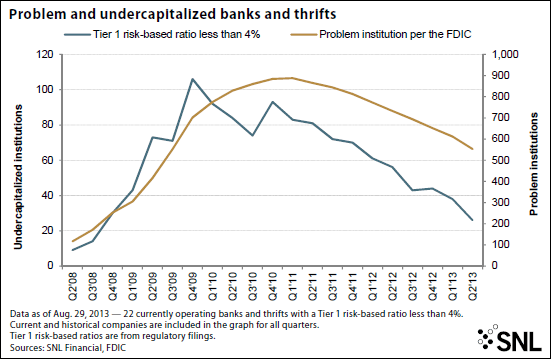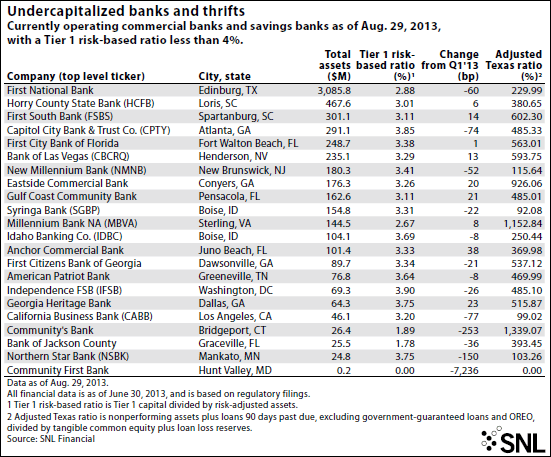Undercapitalized banks fall to lowest level since 2008
SNL Report: And reasons have grown more positive
- |
- Written by SNL Financial
 Undercapitalized banks have been climbing out of the basement, according to SNL analysts.
Undercapitalized banks have been climbing out of the basement, according to SNL analysts.
By Nathan Stovall and Robert Clark, SNL Financial staff writers
The number of undercapitalized banks fell to the lowest level in nearly five years at the end of the second quarter, with more banks escaping undercapitalized territory through positive means in 2013 than in years past.
The FDIC defines undercapitalized banks as those with a total risk-based capital ratio below 8.0%, a Tier 1 risk-based capital ratio below 4.0%, or a Tier 1 leverage capital ratio below 4.0%—unless the bank is a CAMELS 1-rated institution. In that case, a bank would be undercapitalized if its leverage ratio was less than 3.0%.
Shift in undercapitalized ranks
Twenty-six banks and thrifts were undercapitalized, based on the criteria of having Tier 1 ratios below 4%, at June 30, compared to 38 institutions at the end of the first quarter and 56 institutions a year ago, according to SNL data. This represents linked-quarter and year-over-year decreases of 31.6% and 53.6%, respectively.
With the decline in the second quarter, the number of undercapitalized institutions has fallen to the lowest level since the third quarter of 2008, when 14 banks were considered undercapitalized. The number of undercapitalized banks in the industry has steadily declined for the last 11 quarters, with failures—rather than banks finding their way out of capital trouble through other means—accounting for the bulk of the decline.
That trend was consistent through 2012, when the number of undercapitalized banks decreased by 26 to 44 institutions. During that period, a number of banks joined the ranks of the undercapitalized and 51 banks failed. Only 15 banks found their way out of trouble through recapitalizations, mergers, or balance sheet shrinkage and de-risking, coupled with modest earnings in some cases.
The trend has been more positive this year, with eight banks, including three in the second quarter, finding their way out of undercapitalized territory without failing. Just 20 banks have failed so far in 2013—12 of them during the second quarter.
Over the past few years, the number of undercapitalized institutions has declined at a faster rate than the decrease seen in the number of banks on the FDIC's "problem list" on a fairly consistent basis. The number of institutions on the problem list fell to 553 at the end of the second quarter, compared to 612 institutions in the first quarter and 732 a year ago, a 9.6% drop from the linked quarter and down 24.5% from a year ago. The number of problem institutions stood at 865 two years ago but totaled 702 at the end of 2009 and just 252 at end of 2008.


Where the trouble persists
Most problem and undercapitalized institutions continue to be in areas that suffered from stress during the cycle.
Florida, where 69 banks have failed this cycle, had four operating banks falling below the 4% Tier 1 risk-based capital threshold at June 30. Georgia also had four operating, undercapitalized institutions as of June 30. Eighty-eight banks have failed in Georgia this cycle.
The overall pace of resolutions has slowed dramatically in the last two years. Ninety-two banks failed in 2011 after 157 were shuttered in 2010. The pace of failures slowed considerably in 2012, to 51.
One holding company that has long remained in troubled territory has distorted the amount of undercapitalized institutions in the banking industry for some time. Capitol Bancorp Ltd. had eight of its banking subsidiaries among the list of undercapitalized banks for more than two years.
Two Capitol Bancorp subsidiaries previously deemed undercapitalized found their way out of those ranks in the first quarter. However, four other Capitol Bancorp subsidiaries previously deemed undercapitalized failed in the second quarter, and a fifth failed on Aug. 23. (Net, one Capitol Bancorp subsidiary remains in undercapitalized territory.)
In total, seven banks previously deemed undercapitalized have failed since SNL last published the list of undercapitalized banks in the industry. When excluding the banks that have failed or recapitalized since the end of the first quarter, SNL data shows that 22 banks were undercapitalized based on June 30 data, compared to 27 banks at the last publication of the list of undercapitalized banks. The 22 undercapitalized banks reported a median Tier 1 ratio of 3.30% at the end of the second quarter and the group reported median linked-quarter declines in their capital ratio of 14.5 basis points.
Some newcomers joined the list: Five banks, all of which had less than $300 million in assets, joined the ranks of the undercapitalized during the second quarter. A total of 10 banks escaped undercapitalized territory during the second quarter, compared to 18 institutions that escaped those ranks in the first quarter.
Where new capital made the difference
Failures were responsible for the bulk of the decline as raising defensive capital has continued to prove difficult for banks.
However, a handful of banks have enjoyed greater success raising funds this year and generally the transactions have represented full-scale recapitalizations.
• For instance, First Security Group Inc. unit FSGBank NA, was deemed undercapitalized at the end of the first quarter. In April, however, the company recapitalized and downstreamed $65 million in capital to FSBBank, boosting the bank's capital ratios significantly.
• In May, NewDominion Bank raised in excess of $10 million after spending close to a year on the transaction.
• Patterson Bankshares Inc.'s Patterson Bank was recapitalized by investors injecting capital directly into the bank subsidiary. Patterson Bank was renamed First Southern Bank.
• And in June, an investor group completed the recapitalization and purchase of Metrobank's holding company, Chicago-based Metropolitan Bank Group Inc.
Postponed wedding back on again
One institution that remains on the list of undercapitalized institutions, Independence Federal Savings Bank, recently reached an agreement to merge with Colombo Bancshares Inc.
The two parties tried to merge more than three years ago but mutually agreed to terminate the transaction. It is a condition to the completion of the merger that Morton Bender, the sole holder of Independence FSB and Colombo Bank preferred shares, makes an additional common equity investment in Independence FSB prior to closing.
Tagged under Management, Financial Trends,
Related items
- How Banks Can Unlock Their Full Potential
- JP Morgan Drops Almost 5% After Disappointing Wall Street
- Banks Compromise NetZero Goals with Livestock Financing
- OakNorth’s Pre-Tax Profits Increase by 23% While Expanding Its Offering to The US
- Unlocking Digital Excellence: Lessons for Banking from eCommerce Titans














